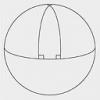-
Posts
1111 -
Joined
-
Last visited
Content Type
Profiles
Forums
Events
Posts posted by elfmotat
-
-
I think everyone would benefit from reading this: http://www.colorado.edu/physics/phys1110/phys1110_fa10/Feynman_energy.pdf .
2 -
R = -T
Yes, this is true with appropriately chosen units.
Now, this site seems to say, that diag(gab) = (1, -1, -1, -1);First off all, the (inverse) metric is not simply diag(1,-1,-1,-1) in general. The metric is related to local matter/energy distribution by the field equations. The Minkowski metric, ημν, which represents flat spacetime is given by diag(1,-1,-1,-1). The Minkowski metric is a special case of the general metric in a vacuum (i.e. Tμν=0).
Now, on to a bigger point: the signs actually depend on your choice of metric signature. You can use the signature (+,-,-,-) as the above author did, or you can use the signature (-,+,+,+). If you use (-,+,+,+), the Minkowski metric becomes: ημν=diag(-1,1,1,1). The choice is completely arbitrary. As long as you pick one and stick with it, all of the consequences work out the same. Most people working with General Relativity tend to use the (-,+,+,+) signature simply because it's easier to deal with one minus than than three. People doing more advanced work, such as work involving spinors, tend to use (+,-,-,-) because it's easier to work with in those fields.
and, that T = diag(Taa) = p ( c2 - vx2 - vy2 - vz2) = p (c2 - v2).T isn't diag(Tμμ), T=Tμμ. The "diag()" would imply that the trace of the SET is still a tensor, which it is not. T is a scalar.
So, T > 0 ? And so, R < 0 ??The sign of T and R depend on your metric signature. Using (+,-,-,-), T>0 and R<0. Using (-,+,+,+), T<0 and R>0. There is no "correct" choice.
In trying to calculate Rab, from the definition:
I thought I found, that many terms cancelled, when one of the dummy indexes was set equal, to one of the formal indexes; that led me to an "einstein strike notation" that simplified the expressions, e.g. with a piece like:
gba,b(gab,a- gba,a) - gba,b(gab,a-gba,a)wherein a dummy index a, b runs over every index, except a, b.
I'm not sure what your question is here.
0



If there is no universal frame of reference then how can time dilation occur?
in Relativity
Posted · Edited by elfmotat
Each object measures their own clock as running normally and the others' as running slow.